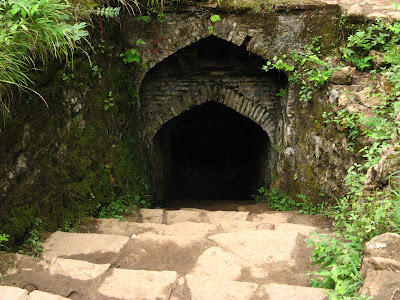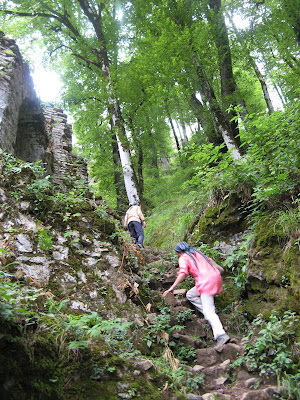Seljuk Turks in the 11th Century led a confederation of Turkic tribes from Central Asia to defeat the Arabic and Islamic Ghaznavid rulers of Persia. They fought their way to Bhagdad and further west into Anatolia (Turkey) in 1071 to defeat the Byzantines.
The Seljuks were already Islamised. They built beautiful buildings with their own style of islamic architecture and it was during the Seljuc era that Persian literature and poetry flourished in Iran. The Seljuk Sultan, Alp Arslan, had a Persian, Hasan Tusi Nizam ol-Mulk (1018-1092), as his chief vizier. Nizam ol-Mulk wrote a book of guidance for the Sultan's successor, which along with other volumes such as the Qabus-nameh influenced European political writing such as Machiavelli's Principle. Nizam ol-Mulk was mates with the famous Persian mathematician and astronomer and poet Omar Khayyam (Axworthy, 2007).



Finally we reached the castle walls.


Ruth didn't want to climb any further but Hannah had gone on ahead. I wanted to continue so I climbed up to the top.
When we got back down Ruth had made lots of friends. She was surrounded by a family who were firing loads of questions at her. They were really sweet and the young girls really liked Ruth. They asked if we could walk down with them so we did. They were from Kerman, a long way south in the desert. They asked us alot of questions about our lives, what we thought about Iran and about our religious beliefs or lack of them.
After we got down the bottom we said goodbye and found a nice little tea place to sit and rest for a while. It was a nice little place. There were Qalyans (water pipes) and a barbeque and interesting ethnic Azeri music. There were brightly painted stones and it had a kind of festival chill-out vibe about it. When I was in the toilet the girl came running back to give me a bracelet she had bought for me as a gift! It was very nice. As we sat there we got chatting to one of the guys who was also there. He was a Zoroastrian. He showed his respect for the Earth by kissing the palm of his hand and touching it on the ground. He gave us a lift back to Masooleh, about 3 hours drive.




















No comments:
Post a Comment